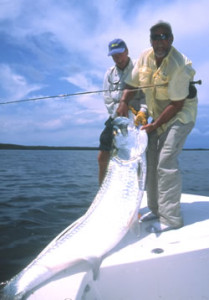(December through May)
 Come December, Dixon moves his base down to Key Largo, Florida, where he guides out of the Ocean Reef Club through late May. The crystal blue shallow waters that hug the Keys and the mangrove islands are the haunt of tarpon, permit, and bonefish; here, sightfishing on the flats – Dixon’s specialty – reaches its highest expression. More than 10 percent of the IGFA saltwater line and fly fishing world records have been recorded in Key Largo, but while location is important, it’s close knowledge of the area, the position of the tide, and proper presentation of the fly that can produce record fish.
Come December, Dixon moves his base down to Key Largo, Florida, where he guides out of the Ocean Reef Club through late May. The crystal blue shallow waters that hug the Keys and the mangrove islands are the haunt of tarpon, permit, and bonefish; here, sightfishing on the flats – Dixon’s specialty – reaches its highest expression. More than 10 percent of the IGFA saltwater line and fly fishing world records have been recorded in Key Largo, but while location is important, it’s close knowledge of the area, the position of the tide, and proper presentation of the fly that can produce record fish.
Spanish explorers christened Key Largo (Large Key) in the 16th century, and pirates and buccaneers who later roamed its shores ignited a fierce independence of spirit. The name Key Largo itself conjures up cinematic images of Bogey and Bacall. But for many anglers, romance lies in the hunt for the illusive bonefish, fooling the wily permit, or jumping a 100-pound tarpon. In January and February, Key Largo offers the best bone fishing in all the Keys; permit follow in massive numbers on to the flats in March. By April, tarpon drop out of the Miami River (Government Cut) and head south to feed on the palolo worm, migrating in schools of 20 to 200 through June. Weather permitting, however, anyone of these fabulous gamefish can be caught at any time during these months.
Some fifty years ago, the Ocean Reef Club began as a tiny fishing camp, nestled in Key Largo’s pristine environment. Though the luxurious, self-contained community has changed since then – featuring three golf courses, tennis courts, a spa, and a private airport – its unspoiled sensibility remains the same, drawing generations of anglers. Surrounded by Biscayne National Park to the north and Pennecamp State Park to the south, the Ocean Reef Club has the feel of civilization in the wilderness.